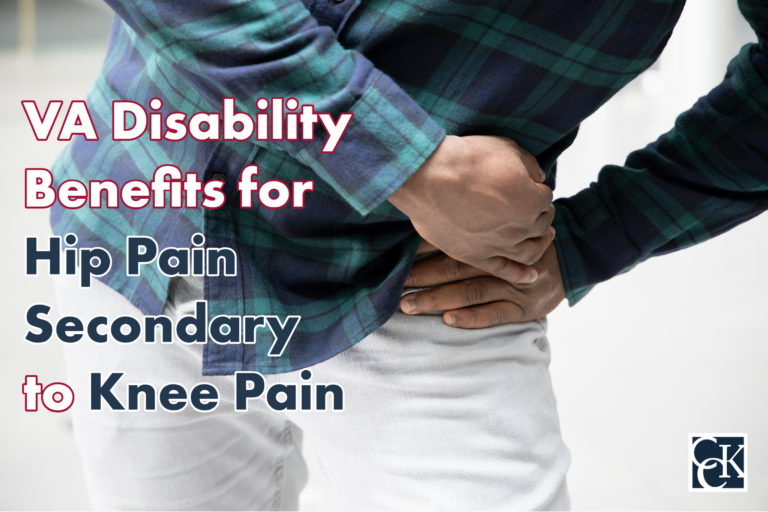VA Disability Benefits for Hip Pain Secondary to Knee Pain

CCK Law: Our Vital Role in Veterans Law
Knee pain is very common among veterans, often due to the physicality of military service. Knee pain can also cause hip pain, or other hip conditions. If your military service caused you to experience knee pain, and eventually hip pain, you may be eligible for additional VA disability benefits. Continue reading for a comprehensive look at how VA rates hip pain secondary to knee pain.
What is Knee Pain and How is it linked to Military Service?
Knee pain can be caused by aging, injury, or repeated stress. Some of the most common knee problems can include sprained ligaments, cartilage tears, tendonitis, and arthritis.
Symptoms of Knee Pain
- Swelling
- Stiffness
- Redness
- Warmth to the touch
- Instability
- Popping or crunching noises
- Inability to straighten
- Aches
As mentioned above, knee pain is extremely prominent among veterans. According to VA’s Annual Benefits Report for Fiscal Year 2020, the limitation of flexion of the knee was the second most prevalent service-connected disability among new compensation recipients (meaning those who became service-connected during the 2020 fiscal year.)
In total, roughly 98,000 veterans newly became service-connected for limitation of flexion of the knee in 2020. This increased from just over 80,000 veterans in 2018, when the condition was the fifth most common among new recipients.
What is Hip Pain?
Hip pain is very common among the general population and can cause a variety of problems and complications. The specific location of an individual’s hip pain can provide important information about the underlying cause.
Hip pain often occurs in the following areas:
- Inside of the hip or groin
- Outside of the hip, upper thigh, or outer buttock (usually caused by problems with muscles, ligaments, tendons, and other soft tissues surrounding the hip joint)
- The hip and the lower back
Importantly, when hip pain is caused by another condition, such as a knee pain, it is called “referred pain.”
How to Establish Direct Service Connection for Knee Pain
To establish direct service connection, veterans must provide the following:
- A current, diagnosed knee condition;
- An in-service event, injury, or illness; and
- A medical nexus linking the current, diagnosed knee condition to the in-service incurrence
Veterans can submit a claim for VA disability benefits on VA Form 21-526EZ. This can be submitted via mail to the Evidence Intake Center or electronically through VA’s website.
Once a veteran’s knee pain is service connected, they may be eligible for secondary service connection for pain in their hip.

How is Knee Pain Rated?
Knee pain can be rated using several different diagnostic codes under 38 CFR § 4.71a. Below are some examples:
Limitation of Flexion of the Knee—Diagnostic Code 5260
Limitation of flexion of the knee is the most common knee condition for which veterans receive VA disability benefits. This condition refers to the range of motion of the knee as the veteran moves or curls it inward towards the body. Typically, VA rates this condition based on the range of motion that exists as the veteran moves their knee in that direction.
Limitation of Extension of the Knee—Diagnostic Code 5261
Limitation of extension of the knee refers to when the knee is not frozen but is limited in extension and cannot straighten all the way. Typically, the greater limitation of extension (or the harder it is to straighten the knee), the higher the disability rating. As with limitation of flexion of the knee, there are specific range of motion measurements that correspond with each disability evaluation.
Instability of the Knee—Diagnostic Code 5257
Instability of the knee refers to when the knee has too much motion from side to side or dislocates regularly. This condition can occur when damaged tendons and cartilage can no longer support the knee joint properly. To get the highest evaluation, the knee must be so unstable that it gives out or dislocates on a regular basis.
Ankylosis of the Knee—Diagnostic Code 5256
Ankylosis is categorized by abnormal stiffening and immobility. Again, the more knee limitation the veteran experiences, the higher the disability rating VA should award.
Total Knee Replacements—Diagnostic Code 5055
If the entire knee joint has been replaced by a prosthesis, then the condition is rated 100 percent for the first 4 months following surgery.
Partial Knee Replacements
Unlike total knee replacements, partial knee replacements do not have their own diagnostic code. Instead, partial knee replacements are rated according to any symptoms that are caused by the replacement such as limitation of motion.
Establishing Secondary Service Connection for Hip Pain
A secondary service-connected condition is one that results from a separate condition that is already service-connected. If a veteran has a hip condition which resulted from a service-connected knee condition, they may be eligible for secondary service connection.
For example, if you suffered a knee injury during your service which causes you to experience instability to the knee, you may be service connected at 30 percent for your knee instability. However, this may place undue pressure on your hips, leading to osteoarthritis. If you experience osteoarthritis in your hips because of the instability of the knee, you may receive secondary service connection at 20 percent for your hip osteoarthritis.
In order to establish secondary service connection, you will need to submit:
- A current diagnosis of hip pain or a hip condition that is secondary to knee pain or a knee condition
- Medical evidence showing the relationship between the knee condition and hip pain
VA Ratings for Hip Pain
VA disability ratings for hip pain depend on the underlying cause and the severity of the pain itself.
Osteoarthritis
If the hip pain is due to osteoarthritis, VA will assign a rating according to 38 CFR § 4.71a, Schedule of Ratings – Musculoskeletal System, Diagnostic Code 5003. The rating criteria are as follows:
- 20% – with X-ray evidence of involvement of two or more major joints or two or more minor joint groups, with occasional incapacitating exacerbations
- 10% – with X-ray evidence of involvement of two or more major joints or two or more minor joint groups
Ankylosis
A hip that suffers from ankylosis (i.e., abnormal stiffening and immobility of a joint due to fusion of the bones) will be rated under Diagnostic Code 5250 as follows:
- 90% – unfavorable, extremely unfavorable ankylosis, the foot not reaching ground, crutches necessitated
- 70% – intermediate
- 60% – favorable, flexion at an angle between 20 degrees and 40 degrees, and slight adduction or abduction
Limitation of Motion
If the hip pain does not result in ankylosis, it will be rated based on limitation of motion. The following measurements are taken into consideration when determining the range of motion:
- Flexion – forward motion of the leg at the hip
- Extension – backward motion of the leg at the hip
- Adduction – inward motion of the leg at the hip
- Abduction – outward motion of the leg at the hip
- Rotation – twisting of the leg at the hip to turn the foot outward
Each of the above-mentioned motions is associated with a “normal” or “typical” range of motion. If a veteran’s hip pain causes limitation of motion outside of the normal range, a disability rating will be assigned accordingly (see 38 CFR § 4.71a).
Hip Replacements
Again, hip pain may become so severe that it requires a hip replacement. VA rates hip replacements under Diagnostic Code 5054:
- 100% – for one year following implantation of prosthesis
- 90% – following implantation of prosthesis with painful motion or weakness such as to require the use of crutches
- 70% – markedly severe residual weakness, pain, or limitation of motion following implantation of prosthesis
- 50% – moderately severe residuals of weakness, pain, or limitation of motion
- 30% – minimum rating
In other words, veterans will receive a 100 percent rating for one year following their hip replacement. After the one-year period, the hip condition will be assigned a permanent rating based on the level of severity as outlined above.
Hip Replacements at a Non-VA Hospital
Veterans often undergo hip replacement surgery at a VA Medical Center; however, some veterans may choose to go to a private, non-VA hospital for the procedure. If this is the case, veterans must inform VA of the hip replacement surgery as soon as possible. If they wait longer than one year following the surgery to inform VA, then the veteran is no longer eligible for the 100 percent disability rating.

Compensation and Pension Exams for Hip Pain Secondary to Knee Pain
If a veteran files a claim for service connection, or secondary service connection, VA may request a compensation and pension exam (C&P). The purpose of a C&P exam is two-fold: to assess whether service connection is warranted, and to gather evidence to award a VA disability rating if service connection is granted.
C&P exams are conducted by a VA examiner or a VA-contracted examiner. During the exam, they may physically examine you or ask questions about your service and your condition(s). They might also ask about your symptoms, or the relationship between your knee pain and hip pain.
It is important to attend any C&P exams that VA requests, even if they request two exams: one for your knee pain and one for your hip pain. Though the exams may seem redundant, attendance is crucial otherwise VA may deny the claim. If the veteran must miss a C&P exam, they should contact VA as soon as possible to try to reschedule.
TDIU for Hip Pain Secondary to Knee Pain
TDIU, or total disability based on individual unemployability, is a monthly VA benefit that compensates veterans at the 100 percent level if they are prevented from working because of their conditions.
In order to be eligible for Schedular TDIU, veterans must have one condition rated at 60 percent minimum OR two conditions that can be combined to reach 70 percent, where one condition is at minimum 40 percent. The criteria for schedular TDIU is outlined under 38 CFR § 4.16a.
Secondary conditions can be very beneficial to help boost a veteran’s overall combined rating, which can help a veteran achieve TDIU. If a veteran is secondarily service connected for their hip pain, both ratings given for hip pain and knee pain can contribute to their TDIU eligibility.
If a veteran does not qualify for schedular TDIU, they may qualify extraschedular TDIU. For this form of TDIU, veterans must prove that their condition(s) uniquely hinder their ability to maintain substantially gainful employment. Extraschedular TDIU is rated under 38 CFR § 4.16b.
How an Accredited Representative Can Help You with Your Hip Pain Secondary to Knee Pain
Accredited representatives can be extremely beneficial in guiding you through the VA appeals process and helping to secure benefits for hip pain secondary to knee pain. Often the appeals system can be very confusing and successfully establishing hip pain secondary to knee pain can be difficult. An accredited representative has the experience necessary to help you navigate the appeals system and can submit documentation to VA on your behalf.
If you need an accredited representation for your VA appeal, let the veterans’ advocates at Chisholm Chisholm & Kilpatrick help. Our experienced team can craft a persuasive argument for your appeal, gather evidence, and communicate with VA on your behalf. If you need help establishing service connection for knee pain or secondary service connection for hip pain secondary to knee pain, call our office today.
About the Author
Share this Post
